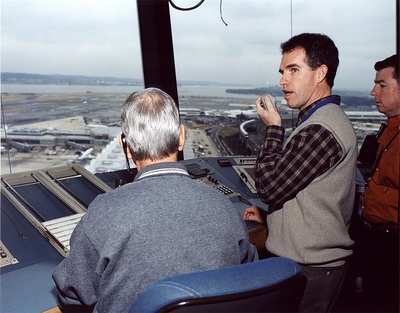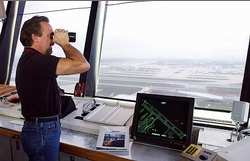SFO Controllers Share Experiences
Following a near-miss at SFO last month due to an error on the
part of a controller with 20 years experience, several area
controllers recently shared their experiences with the (CA) Palo
Alto Daily News.

One controller saw his job as piecing together a 3-dimensional
jigsaw puzzle constantly in flux, which, he said, can be an
adrenaline rush and a challenge.
Because the work is so intense, the FAA requires controllers to
take frequent breaks to avoid burnout.
The goal, said FAA spokesman Ian Gregor, is to give controllers
breathers every two hours, but that does not always happen.
A controller at Oakland Center, which monitors air space
stretching from Australia to the western US, said his work involves
monitoring as many as 22 planes at once.
As an "en route" controller, Conde tracks planes for hours at a
time.
 "On a clear, blue, sunny
day, things are working pretty well," Conde said. "It's not that
big of a deal for someone who has been doing it for 20 years. But
every day there is some sort of an issue, whether it is something
minor to something major."
"On a clear, blue, sunny
day, things are working pretty well," Conde said. "It's not that
big of a deal for someone who has been doing it for 20 years. But
every day there is some sort of an issue, whether it is something
minor to something major."
Minor problems include having to deal with a sick passenger or
having to reroute a plane after a warning light goes on.
Major problems could include a runway "incursion," like the one
that happened on May 26 at SFO in which a pilot was forced to take
off unexpectedly in order to avoid a collision.
That incident, reported by ANN, remains under
investigation by the FAA and NTSB.
The incident occurred when the controller cleared SkyWest
Airlines flight 5741, to land on runway 28R. The same controller
then cleared Republic Airlines flight 4912 to take off from runway
1L, which intersects runway 28R, according to the NTSB.
After the SkyWest airliner touched down, the Airport Movement
Area Safety System (AMASS) sounded in the tower, and the controller
told the SkyWest flight crew to "Hold, Hold, Hold" in an attempt to
stop the aircraft short of runway 1L. The SkyWest crew applied
maximum braking -- that resulted in the airplane stopping in the
middle of runway 1L.
Realizing the aircraft was traveling too fast to stop, the
captain of Republic Airlines flight 4912 took control of the
aircraft from the first officer, and initiated an immediate
takeoff.
According to the crew of SkyWest 5741, the Republic Airlines
aircraft overflew theirs by 30 to 50 feet.
"The initial FAA tower report estimated the aircraft missed
colliding by 300 feet," the NTSB report stated.
Mistakes Can Happen During "Lull" Times
Contrary to what might be popular belief, Conde said it is
easier to make mistakes during lulls in air traffic.
"When you are really, really busy, your mind is working at a
really high rate, trying not to miss anything. As that comes down,
the adrenaline comes down."
FAA officials said controller workload is expected to grow because
air traffic will increase, in some places by as much as 75 percent
by 2025. Additionally, 70 percent of the current pool of air
traffic controllers will retire within the next decade.
 The FAA has 14,600
controllers nationwide and wants to have 16,100 by 2016. Veteran
controllers can make up to $130,000 a year, but new hires make
about $50,000 a year and can earn up to $95,000 after five
years.
The FAA has 14,600
controllers nationwide and wants to have 16,100 by 2016. Veteran
controllers can make up to $130,000 a year, but new hires make
about $50,000 a year and can earn up to $95,000 after five
years.
"It's exhausting (at times)," acknowledged Steve McCoy, an
approach controller in Sacramento. "It's not a demanding job, but
it's very mentally fatiguing."
McCoy's job, working in a windowless area filled with radar
screens, includes lining up airplanes for landings at airports from
Monterey to Red Bluff before turning pilots over to local airport
towers or "en route" controllers.
"We get them airborne and we get them down," he said. "It can be
confusing at times, especially when you are working more than one
sector (of airspace) at a time. You can't afford to second-guess
yourself."
The confusion, said McCoy, who has 25 years' experience as a
controller in the Navy and with the FAA, may happen when two pilots
try talking to him at the same time. That causes technical problems
that prevent him from hearing either pilot. He said in those cases
he may have to jump from conversation to conversation on different
radio frequencies.
At the busiest times, said SFO's Dave Caldwell, tower
controllers could be talking to 15 planes at one time. Caldwell has
27 years of experience with the Navy and FAA.
"Working with aircraft on the ground is a challenge because we
are limited on space," he said.
 Samson Sky Hits the Wind Tunnel
Samson Sky Hits the Wind Tunnel ANN's Daily Aero-Term (05.22.24): LAHSO
ANN's Daily Aero-Term (05.22.24): LAHSO Aero-FAQ: Dave Juwel's Aviation Marketing Stories -- ITBOA BNITBOB
Aero-FAQ: Dave Juwel's Aviation Marketing Stories -- ITBOA BNITBOB ANN's Daily Aero-Linx (05.19.24)
ANN's Daily Aero-Linx (05.19.24) ANN's Daily Aero-Term (05.19.24): Back-Taxi
ANN's Daily Aero-Term (05.19.24): Back-Taxi





